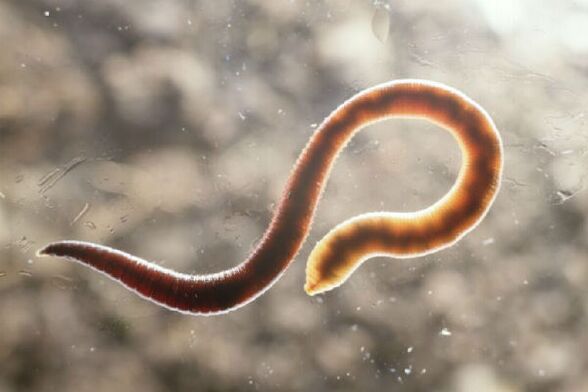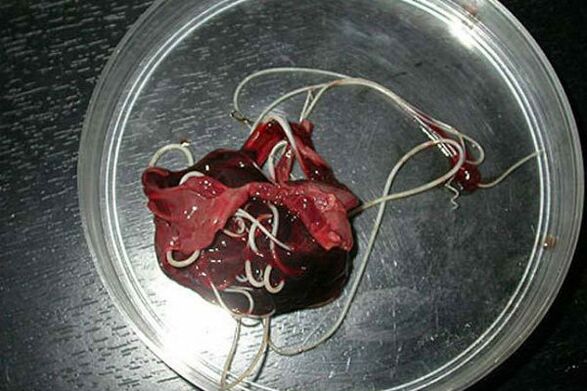
Worms in humans, symptoms and treatment will be guided by a doctor, in the human body is provoked by two types of worms - round (roundworm) and flat (helminth and tapeworm). Each type of parasite causes significant harm to the body, especially if not treated promptly.
Remember to wash your hands when you get home, and also wash vegetables or fruits under warm or hot water because there is a chance of finding parasite eggs on them. Products such as meat, fish or livestock necessarily undergo heat treatment. Under the effect of high temperature, the meat will remove the eggs of the worms, which can be eaten.
Types of roundworms
Pinworms are small, grayish-white parasitic flatworms that awaken intestinal parasites.
Such parasites enter the human body in the following ways:
- alimentary (through the oral cavity);
- through unwashed/dirty hands.
Pinworm eggs can be found in unwashed fruits or vegetables, or in the coats of sick animals. Children who scratch itchy areas and then swallow eggs (for example, along with contaminated food) are more likely to become infected with spirochetes. It takes two weeks to develop pinworm larvae in the environment of the gastrointestinal tract, and after full development, a full-fledged worm lives in all parts of the large intestine.
Trichinella - these parasites have a rounded body no more than 5 mm long and provoke trichinosis in the body. Larvae and eggs prefer poorly fried meats (wild boar, pork, bear meat). In the human body, it takes up to 4 days for Trichinella to mature, and their life cycle is 40 days. The main purpose of this type of worm is to enter the bloodstream through the intestinal wall and settle in the muscles. Furthermore, the muscles of the respiratory and musculoskeletal systems are often affected.
Roundworms are representatives of large size, having the shape of a rotating shaft with a red-yellow color. Males of this species reach a size of 15-25 cm, and females - up to 40 cm. Their bodies do not have any adaptations to fixation in the intestines, they only independently move to the mass of food through the intestines.
You can get ringworm by ingesting mature eggs from eating unwashed vegetables or fruits that have the tiniest particles of soil on them. After the eggs enter the body's internal environment, adult larvae hatch from them, terrorizing the intestinal wall. Through the bloodstream, the parasite can reach the heart muscle and then the lungs.

Only this, the cycle of migration in the body does not end, since the larvae move through the respiratory tract into the mouth.
When re-ingesting the parasites, the body has created an environment favorable for their growth.
The full worm's path will be through the small intestine. Their life cycle is 12 months, after which they die and are excreted in the feces.
Vlasoglavy - human worms, the symptoms and treatment of which are determined at any time after infection, preferring to live directly in the intestines. This worm feeds on blood components or the lining of the intestines.
Females lay eggs directly on the wall of the infected organ, which they then excrete with feces and grow under environmental conditions. The larvae are adults, have an elongated body and do not exceed the limit of 5-15 mm. enter the human body.
These parasites have rounded bodies no more than 5 mm long and provoke trichinosis in the body. Larvae with eggs are found in poor quality fried meat (wild boar, pork, bear meat).
In the human body, Trichinella takes up to 4 days to mature, and their life cycle does not exceed 40 days. The main purpose of this type of worm is to enter the bloodstream through the intestinal wall and settle in the muscles. Furthermore, the muscles of the respiratory and musculoskeletal systems are often affected.
Necator / hookworm. The link between these parasites is direct, with regard to disease-causing agents and biomarkers. They live in the duodenum, and due to their small size (10-15 mm), they move freely in its environment.
The larvae can only enter the body through the skin if a person has been in contact with contaminated soil. The worm's further targets are the lungs along with the gastrointestinal tract. They only feed on blood that flows from the bitten blood vessels. Due to the intense activity of these parasites, blood clotting is disrupted. Adults consume blood in the range of 0, 1-0, 35 ml per day.
Types of flatworms

Wide ribbon. The body length of the parasite, which is 10-20 meters, deserves attention.
The parasite originates in freshwater fish and crayfish, the larvae of which penetrate the eggs and fish fillets.
The process of forming an adult worm takes up to 25 days, and then a person develops diphyllobothriasis (disordered digestive tract, vitamin B deficiency).
The liver fluke is a flatworm, 10 - 20 mm in size, and has a second name for this parasite - cat fluke. In 50% of cases, people who ate infected fish (carp, carp, catfish, perch) suffered. Fish infected with liver fluke by eating snails that had previously eaten helminth eggs with fresh water.
To clean fish from parasites, heat treatment is required, otherwise the larvae will enter the internal environment of the body, damaging the gallbladder along with the intestines. Signs of the acute phase of the development of helminthiasis in humans are a feeling of nausea, which turns into vomiting, pain in the upper abdomen, allergic reactions, muscle spasms. The parasite produces irreversible changes in the body, and even after being expelled from the patient's body, all kinds of inflammation and disorders are bound to occur.
Tapeworms pig / buffalo, cow. The body length of the parasite is 5-6 meters, and its larvae hide in the meat of large animals (pork, cattle). The disease awakened by these worms is called teniasis and teniarinhoz.
The larvae of both species of tapeworm, the Finn, are white sacs attached to the wall of the small intestine. To reach and form an adult, the parasite takes 3 months, and every day the worm grows. The total number of segments is up to 2000, the last segment is free to "groov" the large intestine.
The worms then leave the body with feces through the anus. The most common and obvious symptom of helminthiasis is a disordered gastrointestinal tract, as well as food intake in large quantities and the patient does not gain significant weight.
Echinococcus. In this case, one person acts as the intermediate host, since the last ones are wolves, cats, dogs. Animals can become infected through direct contact with contaminated objects or people. As soon as the eggs of the parasite enter the intestines, larvae with six hooks immediately develop, which are called oncospheres in medicine.

The preferred habitat of the worm is the lungs and liver, the larvae become cysts, increasing in size. All tissues near it are rapidly destroyed.
Doctors often fail to detect echinococcosis and mistake it for a malignant or benign formation. In addition to compression of blood vessels and internal organs, cyst rupture due to echinococcus is also common.
If this happens, not only is the body immediately toxic shock, but the ruptured cyst also stimulates the formation of many new tumours.
The last type of parasite is alveococci, in the medical literature they are called echinococci. It is this worm that awakens a terrible disease that causes harm proportionate to cancer and cirrhosis of the liver. The endocytosis of the worm enters the intestine, then the embryo hatches from the egg and begins to destroy the intestinal wall. After the walls are drilled, the parasite enters the bloodstream and spreads throughout the body.
Usually, as mentioned earlier, the alveoli attack the liver, where the larvae gradually grow. During development, larvae are formed in the worm's body - an aggressive form, rapidly increasing in size (bags with many compartments, gradually getting bigger). These vesicles enter the hepatocytes, following the same principle as cancer metastases.
Adjacent tissues sense a violation of blood flow and subsequent necrotic changes occur in them. Fibrous nodes with such multi-cavity vesicles are formed on adjacent structures and they can persist in the human body for several years. That is why when this parasite is discovered, doctors will resort to surgical intervention.
Note
Modern science knows about 280 species of worms. It is these microorganisms that can parasitize and grow in many types of tissues and organs in the human body.
Each year, these worms in humans, symptoms and treatment determined by doctors, affect the organs and tissues of about 15 million people, and more precisely 80% of them children. .
How you can get worms:
- The use of poorly heat-treated meat dishes or raw meat in general. Therefore, beef is home to tapeworms, pork carries pork tapeworms.
- Consume infected fish in lightly salted or raw form. River water is often contaminated with helminth larvae.
- Water can also cause worms. This is because a person can drink raw water, or wash food and dishes with contaminated water. The risk is especially high when outdoors.
- Soil can also cause the appearance of worms. As it may contain animal or human feces. But how do worms get into the human body? The answer is simple - through unwashed hands after working in the garden or playing outdoors.

In addition, you can become infected through direct contact with an infected person. That is, the infection occurs through dishes, linens or toiletries.
If the case is completely ignored and the parasitic infection is in its acute stage of development, then the doctor will prescribe detoxification and desensitization therapy. And if the disease is very difficult, then glucocorticoids are prescribed.
When it comes to specific therapy, it must take into account the nature of the pathogen and involve special chemotherapeutic agents with anthelmintic properties.
In addition, patients are advised to take antihistamines. At the end of your treatment, you will need to take a course of probiotics. All these are necessary to restore the intestinal microflora. During treatment, the patient must adhere to a special diet, consisting of easily digestible foods with a minimum fat content.
At the time of treatment, it is very important to observe perfect personal hygiene, otherwise there is a risk of reinfection.
In addition, all family members, as well as others who are in frequent and close contact with the patient, should receive deworming treatment.
Signs of worm disease in humans: symptoms in children and adults
Signs of worm disease in humans, the symptoms of which can be the same, can be observed in a sharp form, both in adults and in children:
- Increased appetite and unreasonable salivation, at the same time, rapid weight loss.
- Another variant of the development of symptoms can also occur - the appetite disappears, after eating the patient feels nauseous.
- Perhaps the appearance of headaches and dizziness.
- Loose stools or constipation can also indicate the presence of worms.
- Abdominal pain.
- Sudden onset of allergy with puzzling symptoms.
- Weakened hair and nails (their fragility is increased due to a lack of iron and vitamin B12).
- Due to the weakening of the immune system, various inflammations appear in the nasopharynx and genital area.
If the body is heavily infected with worms, a large amount of toxic substances that appear due to the live activity of the worms will be released into the human blood. This situation can greatly affect the health of the child. First of all, the nervous system is affected. Therefore, if the child suddenly shows signs of aggression, irritability, insomnia and other signs of neurological disorders, the child should be checked for worms or not.

Even without obvious signs, and without dysfunction, worms can still exist in the human body and require frequent testing to identify.
Very often it is the case that after vaccination against diseases, a child develops an allergic reaction due to the presence of toxic substances secreted by worms in the body.
In fact, it is quite difficult to determine whether or not worms are present based on superficial signs alone. After all, the symptoms showing could be a sign of another illness. This task is especially difficult for pregnant women. Because of all the above signs of worms in humans, the symptoms described above, in pregnant women appear due to the process itself.
Therefore, signs of helminth infection in pregnant women can be distinguished by the following symptoms: anal itching and burning in the vaginal area, nocturnal increase, weight loss, fatigue, fever.
To diagnose a helminthic infection, several measures are taken, including the following procedures:
- Take a history to identify possible sources of infection.
- Study samples of stool and blood, rectal and perianal mucus, muscle tissue, sputum, and bile in the laboratory. When performing these operations, it is possible to detect signs of the presence of helminths in the body (eggs or the worms themselves and their parts). It is also important to note that an increased eosinophil count can be an indication of the presence of worms in the body.
- Serological studies (ELISA, RSK, etc. ) allow to detect the presence of larval stage parasites or helminths living in muscle tissues.
- To determine the presence of parasites affecting the liver, ultrasound, CT and endoscopy are prescribed.
Worms in the human liver: symptoms by type of worm
Worms in the human liver, symptoms largely depend on the type of worm, can also migrate to other organs.
The appearance of primary signs of worm infection does not appear immediately. In many ways, the timing of the appearance of particular features depends on the species composition of the parasite. So, the presence of roundworms for almost two to three days is manifested by a deterioration in the general condition of a person.
The first symptoms of infection with other helminths in most cases only begin to appear two to three weeks after the end of the incubation period. There are such parasites (for example, filariasis) in which the incubation period exceeds the six-month mark.
The problem with determining the presence of helminths in the human body is that in the case of primary infection with a small number of worms or a single individual, there are practically no visual signs. Symptoms only begin to appear after the helminths reproduce or when they reach a large size (wide tapeworm, roundworm).
Pinworm infection can be determined most reliably. In their presence, a characteristic itching appears in the anus, which intensifies at night. Basically, the itching occurs within a few days, then subsides for about two weeks and then comes back.
When infected with helminths such as trichuriasis, strongyloidiasis, schistosomiasis, filariasis, beriberi and anemia will develop.
The appearance of symptoms of roundworm infection largely depends on the period of development of the parasite. So, if they are in the early stages of development, the larvae migrate through the bloodstream to most of the internal organs and the following symptoms of the disease will appear: sub-threshold temperature, weakness, cough with phlegmpurulent, volatile infiltrates are visible on chest radiographs, then disappear.
With severe infection, bronchitis and pneumonia can develop. With the further development of the parasite, there is a violation of the functions of the gastrointestinal tract.
Trichinosis - mainly manifests its presence with pain in the muscle tissues, fever and swelling.
Such worms in the human liver, their symptoms are manifested by extra-gastric skin, such as fascioliasis, fascioliasis, fascioliasis, indicating the presence ofthem together with an increase in spleen and liver and other serious disorders of the body.
Almost all worms cause central nervous system disorders, while the sick person feels headache and fatigue, the calm person often becomes irritable and short-tempered, and may appear aggressive attacks. for no reason.






































